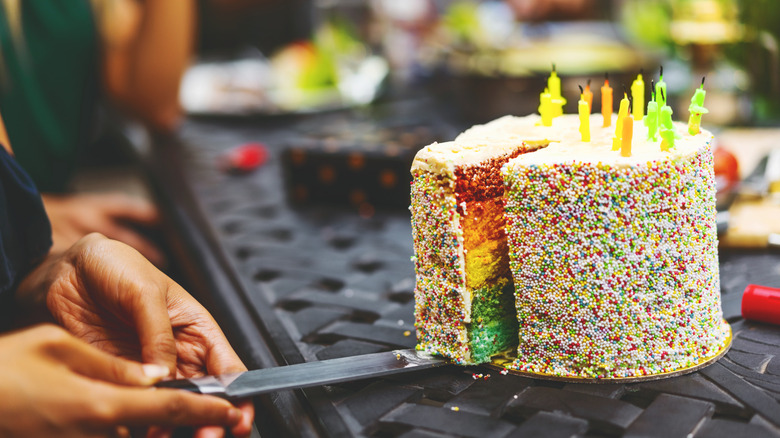When it comes to creative ways to cut a cake, you have an array of options. There are those (likely dentists) who swear by dental floss. Simply cut a length of floss, pull it taut, and use it to slice through a cake as you would a knife. Then, there’s the viral “tongs” method. The beauty of this approach is that, once you’ve cut the cake using the tongs (lay metal tongs on the cake so that the narrow end faces inward, and push down), the utensil can be used to slide that perfect slice onto the plate. No spatula required.
But let’s assume you’re sticking to that classic cake-cutting implement: the knife. There’s nothing wrong with this, of course — assuming you’re using the correct knife. But there are so many types of kitchen knives that using the wrong one can be detrimental to your cake-cutting efforts.
For most sponges, the right knife is going to be a thin, serrated knife. Not, as you might have assumed, a straight-edged knife such as a chef’s knife or carving knife. And certainly not a plastic or butter knife! Each of these may “smoosh” the cake down when cutting it, hindering you from getting a perfectly sharp-edged slice. The serrated edge, on the other hand, should pass through the cake cleanly. When should you opt for a straight edge instead? When you’re cutting a denser dessert such as cheesecake or something similar in texture to banana or zucchini bread.
Have your cake and cut it, too: additional tips
Even if you’ve selected the best knife for the job, cutting cake may prove messier than anticipated, particularly if you’re dealing with a lot of frosting. This may be fine for informal gatherings, but if you’re serving at a wedding — or trying to get slices to a group of ravenous young party guests STAT — you’ll want any extra help you can get.
One of the best techniques for perfectly cut cake every time, in addition to using a serrated knife, is to rinse the knife in hot water in between cuts, making sure to dry it before diving back in. The heated metal glides that much smoother through a crumbly frosted cake, and this technique will help whether you’re using a serrated or straight edge.
An alternative would be to forego the hot water and heat the knife with a kitchen torch. If you go this route, use a damp paper towel to slightly moisten the hot knife before using it, rather than drying it off. In this case, the moisture helps keep the knife a little cleaner. So, whether you’re serving a traditional chocolate or vanilla cake, or reviving a long-forgotten nostalgic cake recipe you forgot existed, reach for the correct knife, and heat it between servings.
